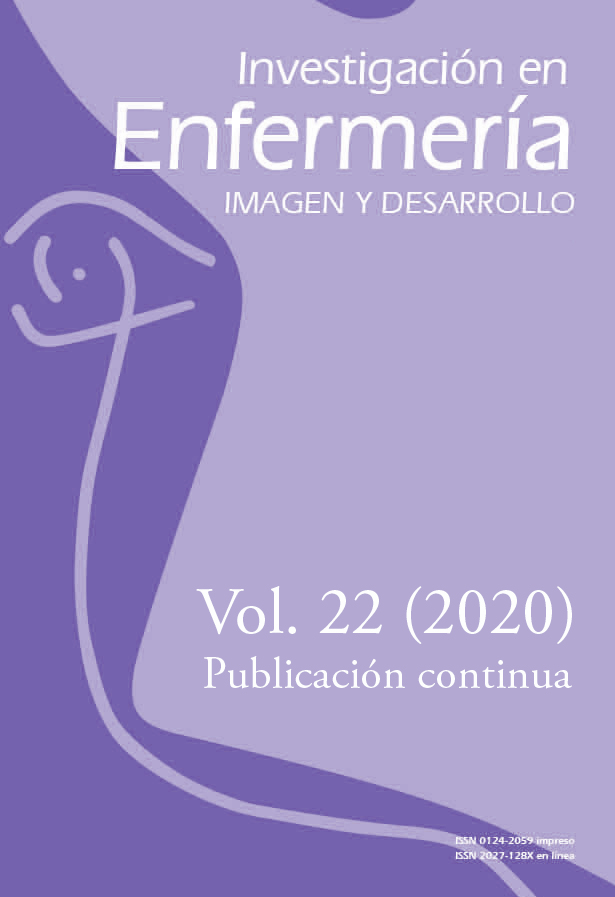Profile of the primary caregiver for diabetic patients in two communities
##plugins.themes.bootstrap3.article.details##
Introduction: Chronic diseases have become one of the most important concerns in modern society given that it means a permanent stay in the healthcare system for patients, while implying that a third party needs to take care of them. Objective: To describe the profile of the primary caregiver for diabetic patients in two Mexican communities. Method: Descriptive cross-sectional study carried out from August 2017 to November 2018 with 38 primary caregivers of people with type 2 diabetes mellitus from two university healthcare clinics (CUAS). Seventeen primary caregivers from the CUAS Zaragoza and 21 from the CUAS Reforma took part of the study. The instrument applied was called Assessment for the Primary Caregiver. Results: The average age of the caregivers is 60 years ± 15 years. The prevailing gender is female. Most caregivers have elementary school education and 68% have a disease. The prevailing relationship with the patients is spouses; 73% of caregivers have the support of their relatives; 55% have an average knowledge about diabetes mellitus and the prevalent caregiver’s value was to respect their patient. Conclusions: Knowing the profile of caregivers will allow nursing professionals to propose different health strategies that will allow them to improve caregiver’s knowledge about this disease and thus improve the lifestyle of patients and provide them with support, given the impact and wear that generates being a primary caregiver for an ill patient.
cuidadores primários cuidador; enfermagem; diabete mellitus tipo 2cuidadores primarios, cuidador, enfermería, diabetes mellitus tipo 2primary caregivers; caregiver; nursing; type 2 diabetes mellitus
2. Hernández-Ávila M, Gutiérrez JP, Reynoso-Noverón N. Diabetes mellitus en México: el estado de la epidemia. Salud Pública Mex. 2013;55(2):129-136. http://dx.doi.org/10.21149/spm.v55s2.5108
3. Venegas-Bustos BC. Habilidad del cuidador y funcionalidad de la persona cuidada. Aquichan [internet]. 2006;6(1):137-47. Disponible en: https://aquichan.unisabana.edu.co/index.php/aquichan/article/view/87
4. Moraga PR. Estudio cualitativo sobre la experiencia subjetiva de la enfermedad en diabéticos. Rev Chil Salud Pública [internet]. 2005;9(3):162-8. Disponible en: https://revistasaludpublica.uchile.cl/index.php/RCSP/article/view/20158
5. Vinaccia S, Quiceno M. Calidad de vida relacionada con la salud y enfermedad crónica: estudios colombianos. Acta. Colomb. Psicol. 2012;6(1):123-36. http://dx.doi.org/10.14718/ACP.2017.20.1.4
6. Guerrero-Nava JA et al. El cuidador primario, su paciente terminal y la enfermería. Rev Enferm Inst Mex Seguro Soc. 2016;24(2):91-8.
7. Ruiz-Robledillo N, Moya-Albiol L. El cuidado informal: una visión actual. Rev Electrón Motiv Emoc [internet]. 2012;1:22-30. Disponible en: http://reme.uji.es/reme/3-albiol_pp_22-30.pdf
8. Pinzón-Rocha M, Aponte-Garzón L, Hernández-Páez R. Experiencia de los cuidadores informales en el manejo de la diabetes mellitus tipo II. Orinoquia. 2013;17:241-51. https://doi.org/10.22579/20112629.22
9. Comas D’argemir Dolors. Los cuidados de larga duración y el cuarto pilar del sistema de bienestar. Rev Antropol Soc. 2015;24:375-404. https://doi.org/10.5209/rev_RASO.2015.v24.50663
10. Hernández-Sampieri R, Fernández-Collado C, Baptista-Lucio P. Metodología de la investigación. 4.ª ed. México: McGraw Hill; 2008. pp. 278-9.
11. Chacón S, Pérez JA, Holgado FP, Lara Á. Evaluación de la calidad universitaria: validez de contenido. Psicothema. 2001;13(2):294-301.
12. Martínez-Cepero FE. Necesidades de aprendizaje del cuidador principal para el tratamiento del anciano con demencia tipo Alzheimer. Rev Cubana Enferm [internet]. 2009 [citado 2018 nov 13];25:(3-4). Disponible en: http://scielo.sld.cu/pdf/enf/v25n3-4/enf06309.pdf
13. Ortiz-Claro YG, Lindarte-Clavijo AA, Jiménez-Sepúlveda MA, Vega-Angarita OM. Características sociodemográficas asociadas a la sobrecarga de los cuidadores de pacientes diabéticos en Cúcuta. Revista Cuidarte. 2013;4(1):459-66. https://doi.org/10.15649/cuidarte.v4i1.5
14. Ambriz-López MC, Villalobos-Arámbula LM, Gallegos-Torres RM, Xeque-Morales AS, Hernández-Castañón MA, Palomé-Vega G. Perfil del cuidador principal y su relación con el cuidado de enfermería. Rev Enferm Inst Mex Seguro Soc [internet]. 2014;22(3):123-9. Disponible en: https://www.medigraphic.com/pdfs/enfermeriaimss/eim-2014/eim143b.pdf
15. Quero-Rufián A, Briones-Gómez R, Prieto-Rodríguez MA, Navarro López A, Pascual-Martínez N, Guerrero-Ruiz C. Perfil y realidad social de los cuidadores familiares en un hospital de traumatología y rehabilitación. Nure Investigación [internet]. 2004;(9):1-14. Disponible en: https://www.nureinvestigacion.es/OJS/index.php/nure/article/view/192/0
16. Lara-Palomino G, González Pedraza Avilés A, Blanco-Loyola LA. Perfil del cuidador: sobrecarga y apoyo familiar e institucional del cuidador primario en el primer nivel de atención. Rev Esp Med-Quir [internet]. 2008;13(4):159-66. Disponible en: https://www.medigraphic.com/pdfs/quirurgicas/rmq-2008/rmq084c.pdf
17. Compean GJM, Silerio VJ, Castillo DR, Parra DML. Perfil y sobrecarga del cuidador primario del paciente adulto mayor con afecciones neurológicas [internet]. Rev Conamed. 2008;13(Suppl 1):S17-21. Disponible en: https://imbiomed.com.mx/1/1/articulos.php?method=showDetail&id_articulo=48629&id_seccion=699&id_ejemplar=4928&id_revista=41
18. Rivera-Mora H, Dávila-Mendoza R, González Pedraza-Avilés A. Calidad de vida de los cuidadores primarios de pacientes geriátricos de la Clínica de Medicina Familiar Dr. Ignacio Chávez. Rev Esp Med-Quir. 2011;16(1):27-32.
19. Ramírez-Alvarado GG. Conocimientos y habilidades de los cuidadores de adultos con diabetes tipo 2 [tesis de maestría]. Bogotá: Universidad Nacional de Colombia; 2012.
20. Eterovic-Díaz C, Mendoza-Parra S, Sáez-Carrillo K. Habilidad de cuidado y nivel de sobrecarga en cuidadoras/es informales de personas dependientes. Enferm Global [internet]. 2015;(38):235-48. Disponible en: http://scielo.isciii.es/pdf/eg/v14n38/administracion4.pdf
21. Vega-Angarita O, Mendoza-Tarazona MK, Ureña-Molina M del P, Villamil Santander WA. Efecto de un programa educativo en la habilidad de cuidado de los cuidadores familiares de personas en situación crónica de enfermedad. Rev Cienc Cuidado. 2008;1(5):5-19. https://doi.org/10.22463/17949831.927

This work is licensed under a Creative Commons Attribution 4.0 International License.


